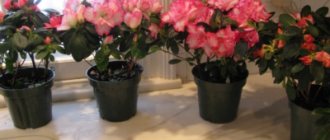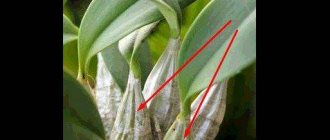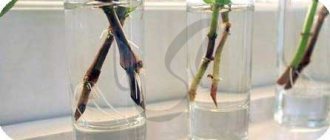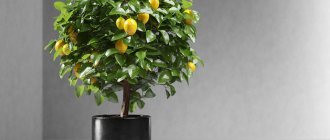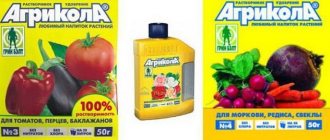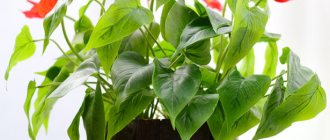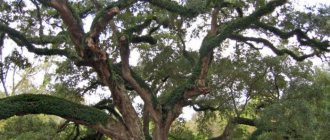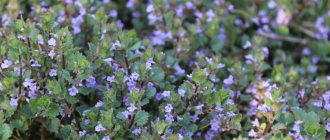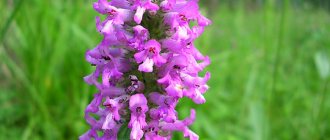This attractive flower came to Russia from the tropical rainforests of Brazil. In its homeland, it is found as a shrub, subshrub, herbaceous plant, and even as an epiphyte plant that lives on another plant, but does not feed on it. It grows in nature up to 70 cm in height, in indoor conditions it is a compact bush no higher than 25 cm with erect or slightly drooping stems.
Hypocyrta glabra, or naked, belongs to the Gesneriaceae family. The name "Hypocyrtos" comes from the Greek words: "hypo" - "bottom" and "cyrcos" - "curved", which is explained by the shape of the flower. It looks like a double one: from the first one with open petals, a second one grows - tubular with fused petals.
Hypocyrta glabra blooms
The plant looks very decorative in an office interior, decorates a balcony in the summer, and creates an atmosphere of comfort in a city apartment and private house.
General description with photo
A more accurate systematization of Hypocyrta was made by Professor Schrader, who included this South American culture in the genus Nematanthus, abolishing the genus of the same name. Its species diversity includes epiphytes, semi-epiphytic vines, and even shrubs and subshrubs.
The leaf blade of Hypocyrta is rounded, short, obovate, with a slight point. The leaf surface is often smooth and glossy, but there are species with pubescence. The back side of the leaf has a purple tint. Flowering occurs in early summer, buds form at the base of the leaf, in the axils. The formed flower has an asymmetrical shape with a significant downward deflection. Erect species grow up to 50-60 cm, and those that produce creeping vines usually do not rise higher than 10-15 cm.
Interesting Facts
Many house plants are associated with some legends and folk superstitions that have come into modern times from the distant past.
They say about the hypocyrtus flower that it brings happiness to the owners of the house, that it relieves stress if you sit next to it, and when you notice the first flower on it, you need to make a wish. If you believe in this, your wish will definitely come true.
It is also believed that it grows poorly among careless owners who do not maintain order in the house, reacting to this with a lack of flowering or a small number of flowers.
Well, where it is given the right good care and due attention, a decorative and original flower from spring to late autumn will delight with abundant and beautiful flowering, bringing positivity and good mood to the house.
Types of hypocyrta with photos
With all the natural diversity in indoor floriculture, the following two varieties are most widespread.
Hypocyrta coin
The species belongs to the ampelous species, in nature it is an epiphyte capable of obtaining food from the air and precipitation. The shoots branch very weakly, the alternately arranged leaves are rounded, fleshy, up to 2 cm long, reminiscent of the leaves of a “money tree”, which is why they got their name. There is slight pubescence on the surface of the leaf blade. The buds are bright red, the elongated corolla is yellow. After flowering ends, the leaves of this indoor plant fall off and it enters a seasonal state of dormancy.
Hypocyrta naked
A variety of semi-ampeloid shape. Like all representatives of the genus, it is characterized by weak branching, practically not producing lateral shoots. In contrast to the light shade of coin-type leaves, it has dark, rich foliage with a smooth, shiny surface without pubescence. But the main difference is the absence of a dormant period with the shedding of leaves; the plant is an evergreen. Axillary flowers are collected in 1-3 buds, the peduncles are short. The waxy petals of their corollas are connected like a spherical lantern with a small hole at the top, bent outward.
In addition to these two common types, there are also lesser known ones, but also worthy of attention.
Hypocyrta tropicana
It has dark green, glossy, diamond-shaped foliage on short petioles. Shoots are upright, weakly branched. It is distinguished by long flowering, which stretches throughout the summer season. The flowers are decorated with stripes of a terracotta shade.
Hypocyrta gregarius
This species has varieties of two colors - with yellow and red buds. It is grown as a hanging crop thanks to its creeping shoots with small glossy leaves. The flowers are also very small, literally miniature in size.
Hypocyrta columnea
Currently, it deserves special attention and love from flower growers; it is singled out as a separate species. The shoots are semi-ampeloid and lodge only when they are of considerable length. It is distinguished by large leaves with a pointed tip. Elongated peduncles lift scarlet flowers above the main green mass, which looks very decorative.
Hypocyrta variegated
Valued for its variegated foliage in two shades of green. In this case, lighter stripes (sometimes almost white) run either along the central vein or along the edge.
A few words about kinship
In the natural environment, hypocyrta is almost a dwarf: only 40-60 centimeters high, and in indoor culture it is even less - 20-30 centimeters. The plant requires constant pruning, since the flowers produce only young shoots, as, for example, in Nematanthus. They are like twin flowers. Previously they belonged to different genera and were synonyms, that is, close.
Today the genera Nematanthus and Hypocyrta are combined into one. Their differences are approximately the same as those of the Idared and Jonathan apple trees - no differences, except that the first variety is bred from the second. Look at the photos of hypocyrta and nematanthus and you will not find the differences.
It has more than a dozen varieties, often with strange additional botanical names. For example, naked is glabra, coined is nummularia. The second differs from the first in greater branching.
Home care
Due to its tropical origin, hypocyrta has its own vagaries and makes quite stringent requirements for growing conditions.
Lighting
For all its love for bright light, the flower prefers diffused lighting without bright direct scorching rays in the summer. For evergreen species, light is also needed in winter, but it is quite sufficient if the daylight hours are artificially extended. The coin variety can spend the winter in a less lit place, and will still feel even more rested.
Temperature
Summer and winter periods should have significant differences in temperature content, and the changes should not be sharp and instantaneous. Late autumn is a period of adaptation to winter dormancy, which, in terms of temperature, is necessary for any variety of this crop.
Air humidity
During the period of intensive growth, hypocyrta requires high environmental humidity. This can be achieved by standard measures - frequent and regular moistening from a spray bottle or installing a tray with wet sphagnum, expanded clay, etc.
Watering
In hot weather, increased watering is required; in spring and autumn, the soil is moistened as the top layer dries out; in winter, the need is sharply reduced, but the earthen clod should not be allowed to dry out completely. The winter watering regime also depends on the variety of hypocyrta; evergreen species will require a little more moisture.
Neither in summer nor in winter should hypocyrta be watered with cold water! It is completely contraindicated for this southern plant.
Soil substrate
It is preferable to choose soil for violets from ready-made compositions. When preparing the substrate yourself, it is recommended to take equal parts of humus, sand, high peat and leaf soil.
Feeding
Feeding coincides in time with the period of intensive growth. A concentrated liquid mineral complex intended for flowering plants is recommended. In autumn and winter, fertilizing is not done to ensure proper rest of the flower.
Conditions of detention
Home conditions should be as close as possible to their natural habitat, providing appropriate care. A native of the tropics has certain requirements for soil, lighting and temperature conditions.
Soil composition
The best soil for hypocyrt is loose, well permeable to water, acidity 5.5-6 (neutral or slightly acidic soil).
These requirements are met by a mixture of 2 parts of leaf soil (from under deciduous trees and shrubs), humus, peat and sand, taken 1 part each. Moss, fine charcoal, crushed bark of coniferous trees, added additionally, will improve the composition of the mixture.
Temperature and lighting
The temperature when the plant is resting and when it is actively growing should be different, as in nature. The optimal temperature for rest is 14°-16°C. In a room where the temperature is lower, leaves are shed.
In summer, a comfortable environment is 19°-24°C. In the heat, the tips of the leaf blade begin to dry out, so you should take this into account when choosing a location.
Under natural conditions, the Nematanthus (hypocyrtus) culture receives a lot of light, but it is diffused due to the plants in the environment. At home, western and eastern windows are suitable, where there is enough light for 12-14 hours. South-facing windows should be lightly shaded to protect from the hot sun.
Watering
The rate and mode of watering is directly related to the environmental conditions and the type of flower.
Requirements:
- use settled water at room temperature;
- water when the top layer of soil in the pot dries out;
- in cold seasons, water moderately; in warm seasons and in hot weather, increase the norm;
- Plants with large leaves should be watered in larger volumes than small-leaved varieties.
Feeding
The application of additional nutrition also depends on the natural cycle of the plant - fertilizing is not applied when it is resting. During the active period (March-October), it is recommended to provide additional nutrition regularly - every 10-15 days. You can use complex phosphorus-potassium fertilizers for flowering crops according to the instructions.
Important! With an overdose and with more frequent feeding, the leaves and shoots become faded and lethargic.
Trimming
When the plant sheds its last flowers and there are no more buds (October), pruning should be done immediately to form a crown. If this is not done, then next year the crown of the flower will lose its decorativeness and density, and there will be much fewer leaves.
An important factor is the timing of pruning. If you delay in carrying it out, the plant may not bloom later, because it will not have time to form flower buds.
The pruning technology is simple: cut shoots of old bushes to ½ length, and of young bushes - by 1/3. Make the cut above the bud, not below it.
On a note! On the new shoots that grow after cutting off the old stems, the flowers form larger and brighter than on the old ones.
Hypocyrta transplant
The culture is slow-growing and therefore does not require annual replanting. Typically, such a need arises every 2-3 years. The container chosen is small, with a small allowance for root growth. An important requirement is the presence of several or one large drainage hole. When filling the pot, it is necessary to provide a wide drainage layer of coarse material; there must be voids in the pot. The plant is an epiphyte, so its roots also need air.
Wintering
Hypocyrta glabra is a tropical plant, so it will not survive frosts. To save it, it is necessary to transplant the crop into pots at the end of September and keep it at home. Procedure:
- Choose a not very large pot.
- Fill it with nutritious substrate. To prepare it, combine the following components: 3 parts leaf soil, 1 part peat soil, ½ part river sand. Also add pieces of charcoal to the soil.
- Replant the plant using the transshipment method, preserving the earthen ball.
- After planting, you need to water the flower and place it in a cool room.
Reproduction
The easiest way to get a new plant is from cuttings taken from a mature specimen. Cuttings should have up to 4-5 internodes; they should be cut during the period of active growth. The lower leaves on them are removed and the cutting is placed in water, perlite or in a loose soil substrate. Rooting of the shoot occurs in comfortable conditions according to the usual rules of crop care.
The seed propagation method is also available, the scheme of which is traditional.
For greater decorativeness, it is recommended to plant several young plants in a permanent container at once, especially for poorly branching varieties with pubescent foliage.
Folk signs and superstitions
Like most indoor plants, nematanthus acquires a lot of beliefs and mysterious signs, namely:
- this flower is capable of attracting wealth to the house; its owner is guaranteed financial well-being and professional growth;
- hypocyrta is a healing flower: if a person is sick, the stems of the plant will certainly droop.
Did you know? Many flower growers have confirmed another theory in practice: if you place a pot of nematanthus next to a sick plant, the sick flower will soon recover from its illness. It is believed that hypocyrta actively releases phytoncides into the atmosphere. This is the name for substances that inhibit the growth and development of pathogenic bacteria.
So, acquaintance with an unusual flower plant called “hypocyrta” makes it possible to draw conclusions about its unpretentiousness. Flower care is simple and accessible even for beginner indoor flora lovers. Following simple rules will allow you to easily grow a magnificent, long-flowering crop that will decorate any room.
Pests and diseases
The most common pathogens that attack Hypocyrtus are aphids, mealybugs and whiteflies. It is also possible to be attacked by scale insects and spider mites. If you carefully examine the plant, signs of insects become obvious - the presence of thin cobwebs, dry or brown spots, mucus, loss of general tone. Some pests are visible to the naked eye. At the first stages of infection, ethyl alcohol, soap solution, or a moderately hot shower are effective (the hand should be able to tolerate the temperature calmly). If there are a lot of insects and signs of their activity are obvious, it is necessary to use chemicals for the appropriate purpose.
Diseases are caused by violation of the rules of care, most often this is a discrepancy between air temperature and watering. The colder the room, the more infrequent watering should be. High humidity and cold air can cause gray mold or powdery mildew. Unhealthy shoots need to be cut off and the plant treated with a fungicidal solution. If the rot has affected the roots, a replantation with a complete revision of the root system is required.
Errors in content
Violations of the rules for caring for hypocyrta lead, accordingly, to developmental disorders. This is indicated by changes in appearance:
- complete absence of flowering or a small number of flowers - lack of light, low humidity, cool room, poor soil, no pruning;
- brown spots on the leaf plate – the water for irrigation is cold (it should be at room temperature, i.e. about 20°C);
- shedding leaves in summer - the soil is too dry, so the roots begin to dry out;
- dropping leaves in the cold season - keeping them at low temperatures;
- drying of the tip of the leaf - high room temperature and low humidity;
- premature dropping of flowers, change in color saturation - water on the flower when watering;
- gray rot - appears when the soil is waterlogged;
- leaves lighten and fade - non-compliance with the dosage of fertilizers (overdose), too bright lighting and dry air.
Neutralizing negative factors will help restore the former decorativeness and attractiveness.
Possible problems and their solutions
- Brown spots on the leaves - watering with cold water or insect damage.
- Hypocyrta does not bloom - there can be many reasons. Pruning was not done, which is why young shoots did not grow, the soil was too poor, there was not enough light, and there was no dormant period.
- Buds and leaves fall - the specimen is flooded against the backdrop of the cold air of the visit. Not to be confused with leaf shedding before dormancy in pubescent varieties!
- The leaves turn yellow and bend - too much exposure to sunlight; you need to diffuse the light, for example, stick tracing paper on the window.
Solarium lover
Although Hypocyrta has emerged from the shadows of the Amazon and other jungles, it is not averse to soaking up the sunshine. In a cultivated environment, it does not like shading, and this will not cause it to bloom, but you need to avoid sending direct rays to it in the garden. Burns may appear on the leaves and the shine will be lost.
Hypocyrta indoors loves plenty of light in winter, but it should not be kept near sources of room heating. The air should not warm up more than 12-16 degrees Celsius. In October-February there is a minimum of watering. In summer - additional irrigation of the bush with a spray bottle.
How to prepare for wintering and care for a flower in winter?
In October, immediately after flowering has ended, the old branches are pruned, in their place in the spring new shoots will grow, in the axils of the leaves of which beautiful flowers similar to goldfish will appear.
In order for the plant to please you with its flowering next year, it needs to rest in winter. To do this, hypocyrta is kept in a bright and cool room.
During the rest period, it is important to follow the rules:
- keep the plant cool, at temperatures up to 12°C;
- provide very moderate watering;
- Maintain daylight for at least 12 hours; artificial lighting can be provided;
- when kept at a warmer temperature, maintain air humidity by spraying;
- the lower the temperature, the lower the humidity.
The minimum permissible temperature is 12°C; when this mark is reached, watering should be stopped.
